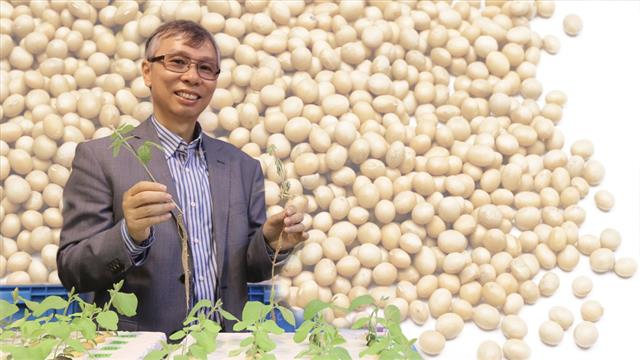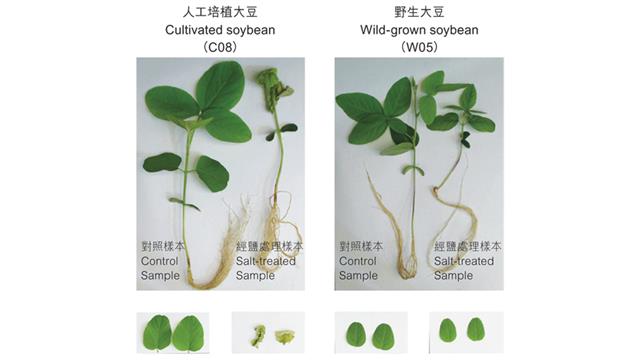The world is running out of farmland to feed its people. According to the UN, the world's population will grow from 7.2 billion in 2013 to 9.6 billion in 2050, yet the area of arable land will only increase by 5% between 2005 and 2050. One major problem is that over 900 million hectares of land is salinized and 10% of this is in China.
Soy and Salinization
China, the world's most populous country, has 6.7 million hectares of saline arable lands, ranking fourth worldwide. The causes of salinization are usually improper irrigation, excessive evaporation of salty underground water, and intrusion of seawater. Salinization hampers both the productivity and quality of crops. Developing salt tolerant crops, therefore, is a pressing issue.
Prof. Lam Hon-ming, professor in the School of Life Sciences and director of the Centre for Soybean Research, has succeeded in identifying the gene that makes soybeans salt tolerant.
Professor Lam's present research is built on a significant discovery he made when he and his team decoded 31 soybean genomes in 2010—wild soybeans have much higher biodiversity than cultivated ones and they may have retained genes that help them to fend for themselves in the natural environment. On the other hand, plants pampered by humans may have lost the genes that enable them to cope with adverse conditions.
Making Use of Wild Germplasm
In this research, Professor Lam and his team extracted the salt-tolerance gene from wild soybeans using the latest technologies in genomics, genetics, and molecular biology. Their target was a wild-grown soybean that's been proved to be highly tolerant to salt. They named it W05. In salt treatment experiments, W05 survived, while its salt-sensitive counterpart, which the researchers named C08, had crumpled leaves and eventually wilted.
Genetic Population
The researchers tried to get W05 and C08 to produce offsprings through artificial pollination. This is a hugely time-consuming process because they need a population that is stable in its genetic makeup. This means breeding not one, but multiple generations. After seven years, the researchers observed that the descendants had reached a level of acclimatization of 99.99%, which means that their genetic changes had stabilized almost completely, allowing the researchers to make reliable and repeated comparisons.
The Genomic Process
Professor Lam and his team then applied state-of-the-art whole genome sequencing to decode the W05 genome and to genotype, in other words, to determine the differences in the genetic makeup, of the population.
'Say we selected 96 types of soybean. Each type has 20 chromosomes. Does each chromosome carry the father's gene or the mother's?' he explains. 'Genetic research in the past used molecular markers, which had very low resolution. But now we can do genetic sequencing on the soybean and find out with far greater accuracy how the father's and the mother's genes are distributed in the offsprings.'
But how do they find the salt-tolerant gene from the haystack of genetic material? The scientists collected data over a number of years from both farmlands and greenhouses. 'It's another tedious process because we need to discount the effects of the natural environment which may change from year to year,' said Professor Lam. 'We observed and measured the traits of the soybeans, such as the size of the seeds and how salt-tolerant they are. Then we used bioinformatics to read the data and try to identify links between the genetic makeup of the plants and their performance in the field.'
Zooming in
The researchers managed to identify the positions of the main genes in 11 of the traits they observed. They also found an area in chromosome 3 of W05 that specifically controls salt tolerance. However there are dozens of genes in that area. Using a variety of methods, the team finally found their target gene.
To make sure that the phenomenon they observed is not restricted to W05 and C08, the team applied the same tests to other soybean germplasms, both wild and cultivated, and found that all salt-tolerant soybeans possess the same gene while in salt-sensitive soybeans, the gene has undergone mutation and lost its function irrevocably. Plants that grow on fertile and well-irrigated lands, mutate to get rid of that gene in order to conserve resources.
Proving with Molecular Biology
The team's next step was to prove, using molecular biology, that the gene is in fact responsible for a plant's salt tolerance. They transferred the target gene into plant cells using a transgenic approach, and found that those given the gene survived the salt treatment much better than those that were not. They also inserted the gene into the roots of the C08 plant, and at the same time, added an unrelated gene into another C08 sample. Comparing the two, they found that the target gene performed much better in surviving salt treatment and offered far greater protection to its host.
This has two implications,' Professor Lam explains, 'First, it means we can protect plants from salt at a cellular level. Second, it means we can influence the accumulation of sodium ion. Sodium ion is one of the major components of salt, and it is toxic. Once it enters a plant cell, it affects physical function. We discovered that the target gene was able to lower the level of sodium ion in the plant.'
Looking Ahead
Professor Lam hopes to collaborate with research units in northeastern and northwestern China to obtain drought-tolerant and highly adaptive soybeans and apply the salt-tolerant gene to them, making them 'super soy' that can grow in the most adverse environments and improve the lives of poor farmers.
The research was published in Nature Communications in July 2014.



